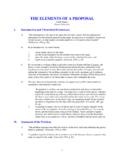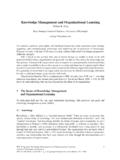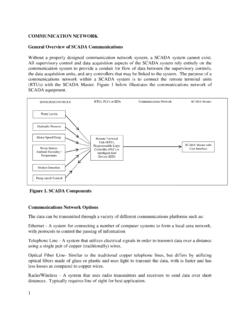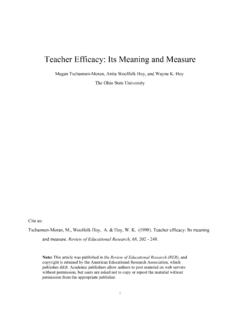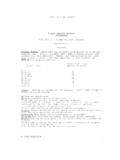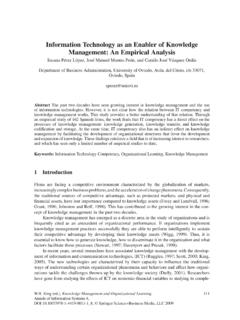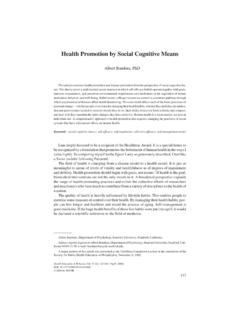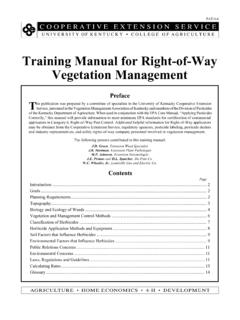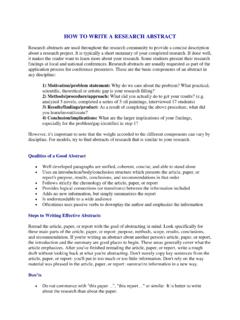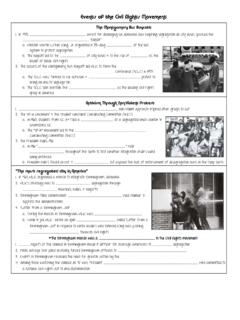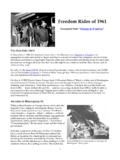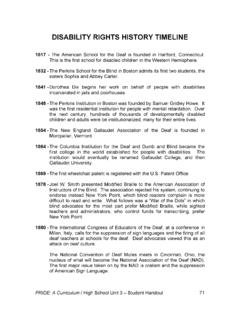Transcription of Sudan Civil War Clayton Thyne clayton-thyne@uiowa.edu ...
1 Sudan Civil War Clayton Thyne introduction Country Background Sudan is a state in central Africa, straddling the cultural and geographic divide of North and sub-Saharan Africa, directly south of Egypt and bordering eight other countries. With an estimated population of 40 million people covering nearly a million square miles (about a quarter of the size of the United States), Sudan is the largest country in Africa. Since gaining independence from Britain in 1956, Sudan has been enveloped in a costly Civil war in all but ten years of its existence. The most recent struggle, begun in 1983, cost the country over 2 million lives and has displaced over 4 million people (CIA Factbook, 2005). Sudan has two distinct major cultures, Arab and Black African, which have different demographics, religions, historical backgrounds and political preferences. The northern Sudanese states include the majority of the population (22 million), cover the majority of the country geographically, and include most of the major urban centers ( , 2005).
2 Historically, the north was deeply influenced by Egypt during the time of the pharaohs. Later, Islamic and Arabic traders left their mark on the northern Sudanese, who primarily speak Arabic and practice Islam (Althaus, 1999). Compared to northern Sudan , the southern region of the country has experienced far more difficulties in the country s short history. The south, which has a population of around 6 million, has endured the brunt of the Civil violence in the country ( , 2005). Southern Sudan has a very heterogeneous population, with some 117 different languages and 50 - 2 - ethnic groups, it resembles traditional African heritage (Althaus, 1999; Sedan Yearbook, 1983). Due to decades of Civil war and neglect by the northern government, southern Sudan has suffered from a severe lack of infrastructural development. The economy is predominantly a rural subsistence economy ( , 2005).
3 Christian missionaries in the early 1900s converted many southerners to Christianity (around 10 percent today). However, most practice some form of traditional African religion. Since becoming independent of Britain, the Sudanese people have consistently endured both repression and poverty. Other than brief periods of democracy (1956 1957, 1965 1968 and 1986 1988), Sudan has suffered under repressive regimes. According to the Polity IV index, which is a measure of a state s regime type, Sudan has been a solid non-democracy in all but 13 years from 1956 through 2002 (Jaggers and Gurr, 1995). This includes the twelve years prior to the onset of the current Civil war and all years during the conflict. Poverty often walks hand-in-hand with repression; Sudan is no exception. With a GDP per capita of less than US $300 at the beginning of the war and a current GDP per capita of US $433, Sudan is among the top ten percent of poorest countries in the world (CIA Factbook, 2005).
4 While not the primary cause of internal conflict, poverty has worked to fuel the flames of rebellion while making civilians the biggest victims of the struggle. Conflict Background One must examine both the history of British colonialism and the role of Islamic fundamentalism to understand Civil war in Sudan . In the early 19th century, Sudan was governed by Egypt, which was part of the Ottoman Empire. Early fault lines developed in the country between the Arab northerners and the black African southerners, who stood on opposing sides of - 3 - the slave trade. In 1879, British General Charles Gordon was given the task by the Egyptians of pacifying Sudan and ending the slave trade. In 1885, Gordon was killed trying to quell a revolt led by Muhammad Ahmad al Mahdi, who sought to revive and purify Islam in the state. Al Mahdi, who was successful in the revolution, and his successor, Khalifa Abdallah, established Sudanese nationalism with close ties to the Islamic faith in their thirteen year rule (Glickman, 2000).
5 Khalifa Abdallah was defeated in 1898 by Lord Kitchener and a British force, which led to the establishment of the Anglo-Egyptian Condominium (1898-1956). This Condominium generally capped internal violence. However, British policies worked to divide the country and can be blamed for much of the violence occurring following their withdrawal from the state. These policies included the support of Islamic Sudanese nationalism in northern Sudan in order to prevent the spread of Egyptian influence and to protect British interest in the Suez Canal (Woodward 1990, 20-5). At the same time, the British worked to spread a distinctly African Sudanese identity in southern Sudan , which was safe from the spread of Islam under British occupation. While the British cannot be blamed for initially establishing the ethno-religious divide between the north and the south, the sixty years of their administration did little to quell the division and likely worked to further divide the country (Daly 1989, 22; Woodward 1990, 4-5, 77-78; Glickman 2000).
6 After the withdrawal of Britain in 1956, the south was immediately marginalized and repressed by the north-dominated national government (Daly 1989, 89; Woodward 1990, 107). Though British policies certainly widened the divide between the north and south, the root of the animosity in Sudan is Islamic fundamentalism in the north, which has consistently discriminated against non-Muslim southerners in their attempt to spread Islam throughout the - 4 - country (Yoynbee 1965, 5-6). The radical Islamist project attempted to establish a state governed under the Islamic laws of the shar ia and viewed jihad (holy war) as an acceptable strategy for pushing Islam throughout the state. Given the Islamic leadership s view of the universal transcendence of Islamic fundamentalism, there has historically been no possibility of integrating Sudan s diverse populations into a single pluralist state (Lowrie, 1993).
7 This view, of course, is unacceptable to non-Muslims in southern Sudan , whose struggle to resist religious repression led to the decades-long Civil war in the country (Glickman 2000). The most recent Sudanese Civil war (1983-2005) was directly related to the first Sudanese Civil war (1956-1972), which began in the first year of independence and lasted nearly sixteen years. The first conflict erupted when the Sudanese government attempted to force Arabic as the country s official language and Islam as the official religion. It ended in 1972 when the government granted the south extensive autonomy ( , 2005). This peace was to be short-lived. In 1982, the central government reneged on many of its promises of self-rule and imposed Islamic law on the whole country, which led to the renewed violence the following year. Additionally, the discovery of vast reserves of oil in southern Sudan intensified the causes for rebellion (Althaus 1999; Glickman 2000).
8 During the first Sudanese Civil war (1956-1972), Chevron discovered oil in the area between the northern and southern regions. Seeing that the oil revenue was disproportionately benefiting the north, combined with the government s reneging on previous promises, southerners were anxious to start the rebellion anew. The rebel groups originally stated overthrowing the government as their fundamental goal. However, in later years of the conflict, southern goals diverged with some wanting complete secession, with others seeking regional autonomy, religious freedom, and profits from natural resource extraction (oil specifically) (Fisher, 1999). - 5 - Since the second Civil war began in 1983, over 2 million people died as a result of fighting, disease and hunger. Another 6 million civilians fled the area, moving mostly to Kenya and Uganda (Althus, 1999). Much of this devastation was due to irresponsible government tactics.
9 According to US government and international human-rights officials, the Islamic state in Sudan committed gross human rights violations and worked to aggravate wide-scale famine throughout the country (Locante, 1993). Other than deaths, Christian and other religious minorities saw their Civil rights restricted continually during the course of the war. Amnesty International reported disturbing accounts of extrajudicial executions, disappearances and torture carried out by the Islamic government in the north (Locante, 1993). During the war, non-Muslims in government-controlled areas were subject to shari a, or Islamic law. Under the 1991 penal code, for example, all non-Muslims were banned from most jobs in the government, including the military and judiciary, could not testify against Muslims in courts, and were required to memorize the Qur an to learn Muslim-based curriculum in the schools (Locante, 1993).
10 The size of both the government s military and the rebel organizations grew over time due to aid from outside forces. At the turn of the century, over 50 percent of the government budget was spent on military supplies (Jok & Hutchinson 1999, 136). Aid from countries such as Iraq, Iran, Saudi Arabia and Libya also contributed to the growth of government forces (Glickman, 2000). The exact size of the rebel organizations was difficult to measure given that the insurgency was generally unorganized and heavily fractionalized, with alliances between rebel groups changing sometimes on a daily basis. The largest rebel organization in Sudan was the SPLA ( Sudan People s Liberation Army). Led by John Garang, the SPLA had great success in the early years of the war. After eight years of fighting, it was able to drive the national army - 6 - out of most of the south (Jok & Hutchinson 1999, 126).

